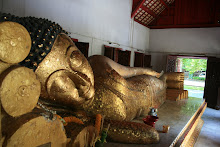Nobel Prize? Probably not.
I also checked the NYT yesterday to find they front pagedsome Nature article on some science stuff that tends to go (according to the NYT) against evolution.
The finding implies that some organisms may contain a cryptic backup copy of their genome that bypasses the usual mechanisms of heredity. If confirmed, it would represent an unprecedented exception to the laws of inheritance discovered by Gregor Mendel in the 19th century. Equally surprising, the cryptic genome appears not to be made of DNA, the standard hereditary material.
The discovery also raises interesting biological questions - including whether it gets in the way of evolution, which depends on mutations changing an organism rather than being put right by a backup system.
From what I gather, it just adds another mechanism for evolution to maintain good genes in the event of mutation. Let me expand on this.
Say humans' survival depended on having five fingers on each hand. Say your parents had 4 fingers each but somehow wound up surviving long enough to reproduce. Now according to this Nature article, you can wind up being born with 5 fingers. This is huge. Supposedly there are only 2 copies of each gene in all of plants and animals. So if your parents had both 2 bad copies of the five finger gene, you should be screwed into having only 4 fingers. But NAY say these scientists, you can get 5 fingers. Granted it is a bit more complicated than this, and there are traits that skip generations (like male pattern baldness, my bane). But gernation skipping uses the orthodox (until now?) mechanism of passing on traits. I digress.
The reasoning behind all this is the wierd part. The scientists say it may be due to RNA being the backup copy. Since RNA is so unstable and easily degraded, Scientists haven't really looked for it. But it seems to me that if there was to be some type of third genome copy it would have been seen in all those cool pictures of chromosomes lining up in the cell and doing the dosey-doe to opposite ends of a splitting cell. You remember those don't you?
But the supposition that Nature makes in saying this can go against evolution is just flat out wrong. The way I see it, if a genetic mutation affects the survival of a species (in the case of the plant researched in the article, it didn't) a bad mutation can whipe out a whole species in a couple of generations. A mechanism that fixes mutations would be beneficial to nature if the mutations were bad. This way we get to keep good mutations, like sickle-cell anemia helps people survive malaria, while loosing bad mutations, like the one that caused Michael Jackson to turn white.
Whatever the mechanism behind this discovery, it seems presumptuous, short-sighted, and at the very least thoughtless for the New York Times, Nature, or any scientist reading this article to say its discovery is bad for the Theory of Evolution. The Theory itself is based on genetic changes that arise to help an animal survive, if the environment changes such that the genetic change is no longer a benefit to the species, another mutation is bound to occur (check the fossil record). The discovery does in fact enrich the Theory to include corrections and revisions to genetic modifications, whatever mechanism they may be based upon.










<< Home